More than a mere exercise, the humble push-up can be viewed as nothing less than a metaphor for life itself.
Think of its motion as mirroring the cyclical, up-and-down nature of existence, almost Sisyphean in movement.
Often, as in life, you are pushing against your own weight, seeking to overcome self-imposed limits.
To perform it well, it takes backbone — both literally and in terms of fortitude.
Push-ups aren’t guaranteed to be easy and can be harsh in the pain they inflict.
Yet, done well, the exercise offers moments of sublime bliss where mind and muscle meld. Like life.
“The push-up should be a little scary,” says Chip Conrad, owner of Body Tribe Fitness in Sacramento, Calif.
“You can’t take the quick and easy route with a push-up. It takes practice, so you need some fear and reverence of it. As with anything, it can either empower or destroy.”
Then again, put aside deep thinking. Push-ups may just be a great workout. And certainly one for this age of frugality.
Such utility, really, is the overriding reason such an old-school exercise has endured in this era of fancy gym equipment, elaborate cross-training regimens and scientific advancements.
What other single exercise in a fitness buff’s repertoire involves muscle groups such as the chest, shoulders, back, arms, abdomen, hips and legs?
And if you perform enough push-ups in a short enough amount of time, it even can provide an aerobic workout.
All that can be accomplished by putting one’s body in a rigid, planklike position and raising and lowering your weight.
Amazing in its simplicity.
“It is very versatile,” says Richard Cotten, an exercise physiologist at the American College of Sports Medicine.
“I’d recommend it to anyone, but I also wouldn’t limit my clients to just doing the push-up.”
The push-up has long been seen as a symbol of virility and vigour, creating a certain cultural cachet.
Who could forget aging actor Jack Palance dropping to perform one-armed push-ups to show his fitness after accepting the Oscar?
Why would a 1950s TV audience become so enthralled with Jack LaLanne’s televised world record of 1,033 push-ups in 23 minutes?
And would Japan’s Minoru Yoshida be a celebrity in his country if he performed a record 10,507 squats in a row rather than push-ups?
The push-up has the power to capture the imagination.
That certainly was the case for Ted Skup, a 57-year-old Indiana man who, more than 25 years ago, decided to perform 1,000 push-ups a day, every day, for the rest of his life.
And he’s still doing them.
He is so dedicated to promoting his exercise of choice that he even wrote an entertaining, self-published book, Death, Taxes & Pushups (Abox Publishing, $18.95, 214 pages).
“People living on the lower income don’t have the luxury of personal trainers, gym memberships, supplements and flex machines — this is free and portable,” Skup said in an interview.
“You come home from work and got to take kids to basketball or swim practice. In the real world, you don’t have time to drive to the gym, spend two hours there on a complete workout. Life doesn’t work like that.”
So Skup weaned himself from the gym and started doing push-ups during breaks at work, at home, at the mall — any time he could fit in five minutes or so.
“After a year, I looked in the mirror and saw I looked just as good as I did when I lifted weights,” he says.
“It’s like being in a health club and doing everything at once. It’s the most portable exercise ever invented.”
Conrad, the Body Tribe owner, says push-ups are a core part of “a medley of exercises I give to people when they’re traveling and can’t get to a gym.” (Others include squats and yoga moves.)
Even if you have access to a gym full of fancy machines, the push-up trumps even something as basic as the bench press.
Trainer Alwyn Cosgrove, in Men’s Fitness magazine, recently wrote, “A guy shouldn’t even attempt to pick up a dumbbell until he can handle his own body weight. . . . Most guys don’t realize how tough body-weight-only training really is. I’m continually amazed by how many people I meet who can bench press a very heavy load but can’t complete 10 good push-ups.”
Conrad, who often trains personal trainers, says many weightlifters don’t show push-ups the proper respect.
Many variations of the standard push-up exist. Body position determines the emphasis on a particular muscle group.
For instance, if one’s hands are set closer than the shoulder width, the triceps receive a greater workout.
Other popular variations include, from easiest to hardest, the modified push-up (knees, rather than toes, supporting your weight), the incline push-up (hands braced on the wall or bench) and the decline push-up (feet elevated on a bench).
Conrad often combines standard push-ups with yoga moves for hybrid exercises that tax the body more. But he also is a big proponent of the regular old push-up.
“I think slower push-ups, where you want to be like a table top, teach postural concepts so that you can know your proprioception (an inner sense of the position of your body parts),” Conrad says.
“More explosive push-ups are great for sports performance, where you need to turn everything on quickly.
“You can change your body positioning in a push-up, too, steal some things from yoga.”
Distributed by Scripps Howard News Service, www.scrippsnews.com
